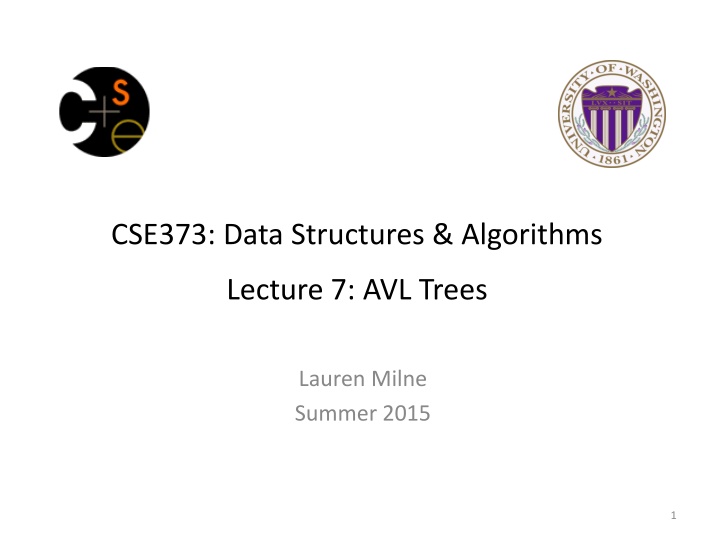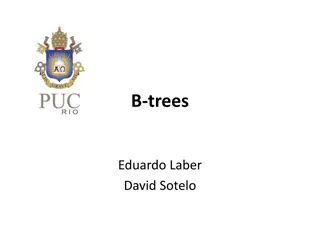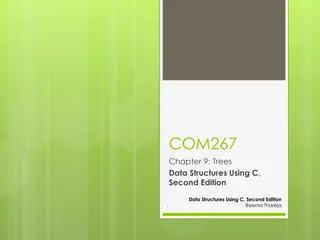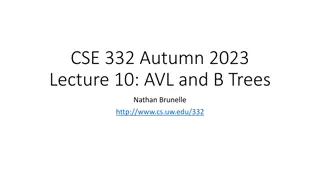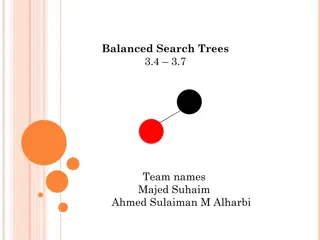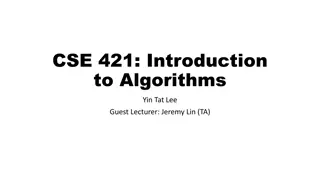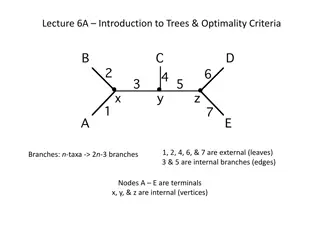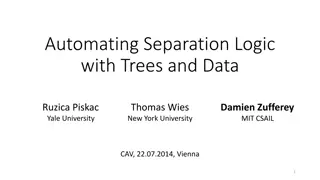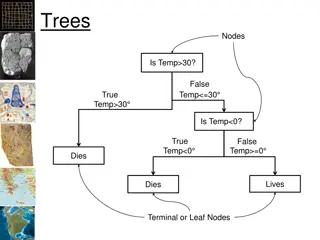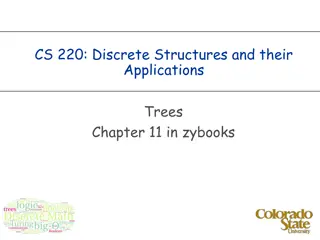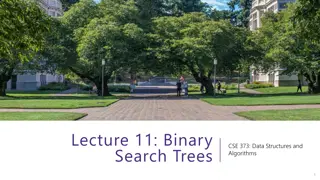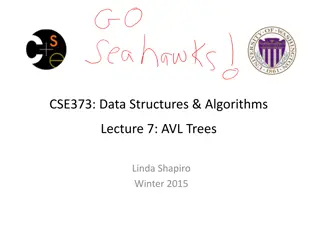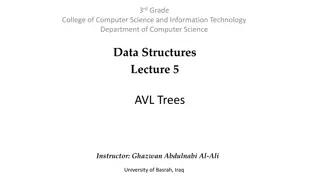Efficient BST Operations and AVL Trees
How balance conditions impact binary search trees (BST), introducing AVL trees as self-balancing structures, exploring efficient operations and tree maintenance. Dive into AVL tree properties, balancing techniques, and complexity analysis.
Download Presentation

Please find below an Image/Link to download the presentation.
The content on the website is provided AS IS for your information and personal use only. It may not be sold, licensed, or shared on other websites without obtaining consent from the author.If you encounter any issues during the download, it is possible that the publisher has removed the file from their server.
You are allowed to download the files provided on this website for personal or commercial use, subject to the condition that they are used lawfully. All files are the property of their respective owners.
The content on the website is provided AS IS for your information and personal use only. It may not be sold, licensed, or shared on other websites without obtaining consent from the author.
E N D
Presentation Transcript
CSE373: Data Structures & Algorithms Lecture 7: AVL Trees Lauren Milne Summer 2015 1
How can we make a BST efficient? Observation BST: the shallower the better! Solution: Require a Balance Condition that 1. Ensures depth is alwaysO(logn) 2. Is efficient to maintain When we build the tree, make sure it s balanced. BUT Balancing a tree only at build time is insufficient. We also need to also keep the tree balanced as we perform operations. 2
Potential Balance Conditions 1. Left and right subtrees of the root have equal number of nodes Too weak! Height mismatch example: 2. Left and right subtrees of the root have equal height Too weak! Double chain example: 3
Potential Balance Conditions 3. Left and right subtrees of every node have equal number of nodes Too strong! Only perfect trees (2n 1 nodes) 4. Left and right subtrees of every node have equal height Too strong! Only perfect trees (2n 1 nodes) 4
The AVL Balance Condition Left and right subtrees of every node have heights differing by at most 1 Definition: balance(node) = height(node.left) height(node.right) AVL property: for every node x, 1 balance(x) 1 Ensures small depth Will prove this by showing that an AVL tree of height h must have a number of nodes exponential in h (i.e. height must be logarithmic in number of nodes) Efficient to maintain Using single and double rotations 5
Announcements HW2 due 10:59 on Friday via Dropbox. Midterm next Friday, sample midterms posted online Last lecture: Binary Search Trees Today AVL Trees 6
BST: Efficiency of Operations? Problem: operations may be inefficient if BST is unbalanced. Find, insert, delete O(n) in the worst case BuildTree O(n2) in the worst case 7
The AVL Tree Data Structure An AVL tree is a self-balancing binary search tree. Structural properties 1. Binary tree property (same as BST) 2. Order property (same as for BST) 3. Balance property: balance of every node is between -1 and 1 balance(node) = height(node.left) height(node.right) Result: Worst-case depth is O(log n) 8
Is this an AVL tree? 3 6 1 2 4 8 0 1 11 0 1 7 0 0 12 10 Yes! Because the left and right subtrees of every node have heights differing by at most 1 9
Is this an AVL tree? 4 6 3 1 4 8 2 1 5 7 11 0 0 0 3 1 2 0 Nope! The left and right subtrees of some nodes (e.g. 1, 4, 6) have heights that differ by more than 1 10
Good news Because height of AVL tree is O(log(n)), then find is O(logn) But as we insert and delete elements, we need to: 1. Track balance 2. Detect imbalance 3. Restore balance 11
An AVL Tree Node object key 10 3 value 10 height 3 2 2 children 5 20 1 1 0 0 15 30 2 9 0 0 7 17 Track height at all times! 12
AVL tree operations AVL find: Same as BST find AVL insert: First BST insert, thencheck balance and potentially fix the AVL tree Four different imbalance cases AVL delete: The easy way is lazy deletion Otherwise, do the deletion and then check for several imbalance cases (we will skip this) 13
Insert: detect potential imbalance 1. 2. Insert the new node as in a BST (a new leaf) For each node on the path from the root to the new leaf, the insertion may (or may not) have changed the node s height So after insertion in a subtree, detect height imbalance and perform a rotation to restore balance at that node Always look for the deepest node that is unbalanced 3. 4. h+2 a h+1 h b h h Z X Y 14
Insert: detect potential imbalance 1. 2. Insert the new node as in a BST (a new leaf) For each node on the path from the root to the new leaf, the insertion may (or may not) have changed the node s height So after insertion in a subtree, detect height imbalance and perform a rotation to restore balance at that node Always look for the deepest node that is unbalanced 3. 4. h+3 a h+2 h b h+1 h Z X Y 15
Case #1: Example Insert(6) Insert(3) Insert(1) 0 1 2 6 6 6 0 1 3 3 Third insertion violates balance property -happens to be at the root 0 1 1 What is the only way to fix this? 3 0 0 6 1 16
Fix: Apply Single Rotation Single rotation:The basic operation we ll use to rebalance Move child of unbalanced node into parent position Parent becomes the other child (always okay in a BST!) Other subtrees move in only way BST allows (next slide) AVL Property violated at node 6 1 2 3 6 1 0 0 3 1 6 0 1 Child s new-height = old-height-before-insert 17
The example generalized Insertion into left-left grandchild causes an imbalance 1 of 4 possible imbalance causes (other 3 coming up!) Creates an imbalance in the AVL tree (specifically a is imbalanced) h+2 a h+3 a h+1 h+2 h b h b h h h+1 h Z Z X Y X Y 18
The general left-left case So we rotate at a Move child of unbalanced node into parent position Parent becomes the other child Other sub-trees move in the only way BST allows: using BST facts: X < b < Y < a < Z h+3 h+2 a b h+2 h+1 h a b h h+1 h+1 h h Z X X Y Y Z A single rotation restores balance at the node To same height as before insertion, so ancestors now balanced 19
Another example: insert(16) 15 8 22 24 19 4 10 6 3 17 20 16 15 8 19 22 4 10 17 16 20 24 6 3 20
The general right-right case Mirror image to left-left case, so you rotate the other way Exact same concept, but need different code h+3 a h+2 b h+2 h h+1 b h+1 a h X h h h+1 Z Y Z X Y 21
Right-right Imbalance 15 8 22 24 4 10 19 6 3 23 25 26 22
Right-right Imbalance 15 8 24 22 4 10 25 6 3 19 23 26 23
Two cases to go Unfortunately, single rotations are not enough for insertions in the left-right subtree or the right-left subtree Simple example: insert(1), insert(6), insert(3) First wrong idea: single rotation like we did for left-left 2 1 1 Violates order property! 6 1 6 0 0 3 1 0 3 24
Two cases to go Unfortunately, single rotations are not enough for insertions in the left-right subtree or the right-left subtree Simple example: insert(1), insert(6), insert(3) Second wrong idea: single rotation on the child of the unbalanced node 2 2 1 1 Still unbalanced! 1 1 6 3 0 0 3 6 25
Sometimes two wrongs make a right First idea violated the order property Second idea didn t fix balance But if we do both single rotations, starting with the second, it works! (And not just for this example.) Double rotation: 1. Rotate problematic child and grandchild 2. Then rotate between self and new child 2 2 1 1 1 3 1 6 1 3 0 0 0 0 3 1 6 6 26
The general right-left case h+3 a h+2 h b h+1 h c X h h-1 Z V U h+2 c h+3 h+1 a h+1 b h+2 a h h c h h h+1 h h-1 b U X h-1 V X U Z h V Z 27
Comments Like in the left-left and right-right cases, the height of the subtree after rebalancing is the same as before the insert So no ancestor in the tree will need rebalancing Does not have to be implemented as two rotations; can just do: h+3 h+2 a c h+2 h b h+1 h+1 h+ 1 b h a c h X h h h-1 h h-1 Z U V V X U Z Easier to remember than you may think: Move c to grandparent s position Put a, b, X, U, V, and Z in the only legal positions for a BST 28
The last case: left-right Mirror image of right-left Again, no new concepts, only new code to write h+3 h+2 a c h+2 h b h+1 h+ 1 h+1 a b c h Z h h h h-1 h h-1 U V X X U Z V 29
Insert, summarized Insert as in a BST Check back up path for imbalance, which will be 1 of 4 cases: Node s left-left grandchild is too tall Node s left-right grandchild is too tall Node s right-left grandchild is too tall Node s right-right grandchild is too tall Only one case occurs because tree was balanced before insert After the appropriate single or double rotation, the smallest- unbalanced subtree has the same height as before the insertion So all ancestors are now balanced 30
AVL Trees efficiency Worst-case complexity of find: O(logn) Tree is balanced Worst-case complexity of insert: O(logn) Tree starts balanced A rotation is O(1) and there s an O(logn) path to root Tree ends balanced Worst-case complexity of buildTree: O(n logn) Takes some more rotation action to handle delete 31
Pros and Cons of AVL Trees Arguments for AVL trees: 1. All operations logarithmic worst-case because trees are always balanced Height balancing adds no more than a constant factor to the speed of insert and delete 2. Arguments against AVL trees: 1. 2. 3. 4. Difficult to program & debug [but done once in a library!] More space for height field Asymptotically faster but rebalancing takes a little time If amortized (later, I promise) logarithmic time is enough, use splay trees (also in the text) 32
